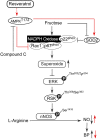Resveratrol Inhibition of Rac1-Derived Reactive Oxygen Species by AMPK Decreases Blood Pressure in a Fructose-Induced Rat Model of Hypertension
- PMID: 27138844
- PMCID: PMC4853785
- DOI: 10.1038/srep25342
Resveratrol Inhibition of Rac1-Derived Reactive Oxygen Species by AMPK Decreases Blood Pressure in a Fructose-Induced Rat Model of Hypertension
Abstract
Recent studies have reported that the activation of AMP-activated protein kinase (AMPK) suppressed oxidative stress. The aim of this study was to examine whether the activation of AMPK in the brain decreased Rac1-induced ROS generation, thereby reducing blood pressure (BP) in rats with fructose-induced hypertension. The inhibition of ROS by treatment with an AMPK activator (oral resveratrol, 10 mg/kg/day) for 1 week decreased the BP and increased the NO production in the rostral ventrolateral medulla (RVLM) of fructose-fed rats but not in control Wistar-Kyoto (WKY) rats. In addition, resveratrol treatment abolished the Rac1-induced increases in the activity of the NADPH oxidase subunits p22-phox and reduced the activity of SOD2, while treatment with an AMPK inhibitor (compound C, 40 μM/day) had the opposite effect, in the fructose-fed rats. Interestingly, the activation of AMPK abolished Rac1 activation and decreased BP by inducing the activities of extracellular signal-regulated kinases 1 and 2 (ERK1/2) and ribosomal protein S6 kinase (RSK) and nNOS phosphorylation in the fructose-fed rats. We conclude that the activation of AMPK decreased BP, abolished ROS generation, and enhanced ERK1/2-RSK-nNOS pathway activity by negatively regulating Racl-induced NADPH oxidase levels in the RVLM during oxidative stress-associated hypertension.
Figures





Similar articles
-
Resveratrol regulates blood pressure by enhancing AMPK signaling to downregulate a Rac1-derived NADPH oxidase in the central nervous system.J Appl Physiol (1985). 2018 Jul 1;125(1):40-48. doi: 10.1152/japplphysiol.00686.2017. Epub 2018 Mar 1. J Appl Physiol (1985). 2018. PMID: 29494287
-
Resveratrol decreases fructose-induced oxidative stress, mediated by NADPH oxidase via an AMPK-dependent mechanism.Br J Pharmacol. 2014 Jun;171(11):2739-50. doi: 10.1111/bph.12648. Br J Pharmacol. 2014. PMID: 24547812 Free PMC article.
-
Anomalous AMPK-regulated angiotensin AT1R expression and SIRT1-mediated mitochondrial biogenesis at RVLM in hypertension programming of offspring to maternal high fructose exposure.J Biomed Sci. 2020 May 23;27(1):68. doi: 10.1186/s12929-020-00660-z. J Biomed Sci. 2020. PMID: 32446297 Free PMC article.
-
Role of reactive oxygen species in brainstem in neural mechanisms of hypertension.Auton Neurosci. 2008 Nov 3;142(1-2):20-4. doi: 10.1016/j.autneu.2008.06.001. Epub 2008 Jul 22. Auton Neurosci. 2008. PMID: 18650132 Review.
-
AMP-Activated Protein Kinase as a Reprogramming Strategy for Hypertension and Kidney Disease of Developmental Origin.Int J Mol Sci. 2018 Jun 12;19(6):1744. doi: 10.3390/ijms19061744. Int J Mol Sci. 2018. PMID: 29895790 Free PMC article. Review.
Cited by
-
Resveratrol Action on Lipid Metabolism in Cancer.Int J Mol Sci. 2019 Jun 1;20(11):2704. doi: 10.3390/ijms20112704. Int J Mol Sci. 2019. PMID: 31159437 Free PMC article. Review.
-
The Bewildering Effect of AMPK Activators in Alzheimer's Disease: Review of the Current Evidence.Biomed Res Int. 2020 Feb 18;2020:9895121. doi: 10.1155/2020/9895121. eCollection 2020. Biomed Res Int. 2020. PMID: 32149150 Free PMC article. Review.
-
The citrus flavonoid naringenin confers protection in a murine endotoxaemia model through AMPK-ATF3-dependent negative regulation of the TLR4 signalling pathway.Sci Rep. 2016 Dec 22;6:39735. doi: 10.1038/srep39735. Sci Rep. 2016. PMID: 28004841 Free PMC article.
-
Syk promotes phagocytosis by inducing reactive oxygen species generation and suppressing SOCS1 in macrophage-mediated inflammatory responses.Int J Immunopathol Pharmacol. 2022 Jan-Dec;36:3946320221133018. doi: 10.1177/03946320221133018. Int J Immunopathol Pharmacol. 2022. PMID: 36214175 Free PMC article.
-
Accelerated inflammation and oxidative stress induced by LPS in acute lung injury: Ιnhibition by ST1926.Int J Mol Med. 2018 Jun;41(6):3405-3421. doi: 10.3892/ijmm.2018.3574. Epub 2018 Mar 19. Int J Mol Med. 2018. PMID: 29568857 Free PMC article.
References
-
- Tagawa T. et al. Nitric oxide influences neuronal activity in the nucleus tractus solitarius of rat brainstem slices. Circ Res 75, 70–76 (1994). - PubMed
-
- Hirooka Y. Oxidative stress in the cardiovascular center has a pivotal role in the sympathetic activation in hypertension. Hypertens Res 34, 407–412 (2011). - PubMed
Publication types
MeSH terms
Substances
LinkOut - more resources
Full Text Sources
Other Literature Sources
Medical
Molecular Biology Databases
Research Materials
Miscellaneous

